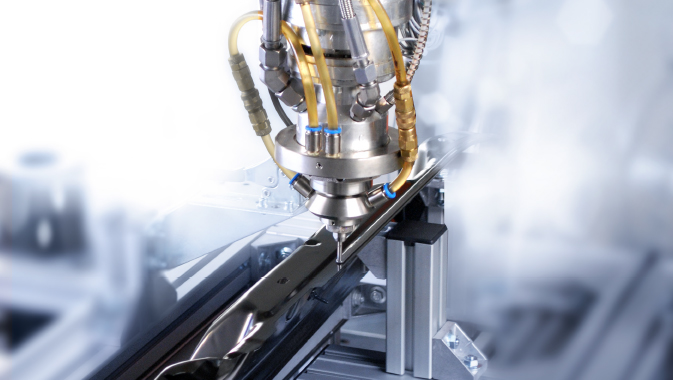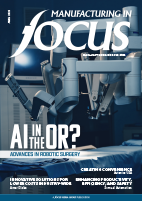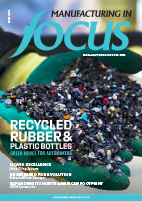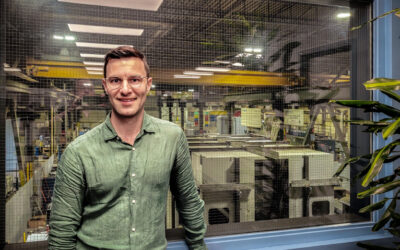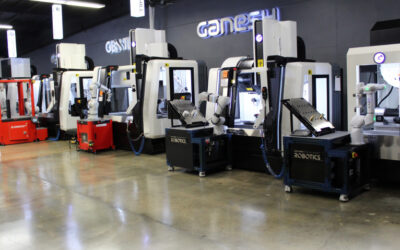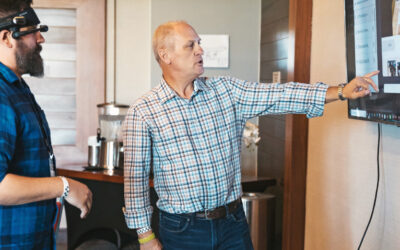RAMPF engineers have developed an intelligent machine bed with cooling lines and sensors to prevent production malfunctions. They’ve also helped Reebok make running shoes from 3D drawings with a specialized liquid dispensing technology. Yes, the factory of the future has arrived.
~
These days, ultra-fast production processes are essential for staying ahead of the competition. Whether you’re making exterior car parts like rocker panels and spoilers, seat backrests for business jets, or the next exceptional athletic shoe, manufacturers are looking for the most efficient, reliable systems and materials to keep pace with demand – and impress their clients.
That’s where RAMPF Group comes in, a family-owned company out of Germany with locations around the globe and a strong American presence headquartered in Wixom, Michigan since 2004. The company’s contract manufacturing locations include Wixom, Suwanee, Georgia, and Montgomery, Alabama. RAMPF is a multi-faceted engineering and chemicals solutions firm that offers everything from the materials needed to the manufacturing process to the finished product.
“The level of automation is increasing,” says Mike Erby, Division Manager for Production Systems at RAMPF Group, Inc., the U.S. subsidiary of RAMPF Group. “And it’s changing the roles of what people do in factories. The monotonous handwork is being automated by robotics and cameras and other interconnected devices.”
He has seen smart machines come of age over the last 18 years he’s worked in manufacturing, the last 16 of which have been with RAMPF. Once you’re on the RAMPF team, with 79 employees in North America, you tend to stay to be part of its leading-edge innovation.
Erby plays a key role in concept development and sales of robotic dispensing equipment and part-handling automation systems, many of which are fully automated. He says people on the factory floor today are working alongside robots – “cobots” or collaborative robots – the new coworkers in the digital revolution. (Star Wars’ C-3P0 droid may have been good company, but RAMPF’s DR-CNC, a three-axis dispensing robot, and six-axis industrial robots are used for multiple roles in part-handling, dispensing, plasma-treating and inspection.)
Laser technology, often associated with advancements in medical procedures, is also coming to the forefront in manufacturing. “Lasers and cameras are used to identify part types, locate parts, and check quality of finished parts. Lasers mounted on the robot can see a part and tell the robot to start processing the part. Cameras, either fixed or robot-mounted, “can see the part and identify part type, tell the robot its location, pick it up and move it to the next process step. Once complete, other stationary cameras can look at a part to determine if the material is correctly applied. Devices can then remove defective parts for 100 percent inspection and control, Erby says. “Machines communicate with each other using these and other peripheral devices allowing for faster changeover, mixed model production and flexibility in manufacturing processes.”
This is what RAMPF engineers, technicians, chemists and inventors talk about. It’s part of the job to collaborate with colleagues and clients, and often create very customized, next-gen solutions. They’re focused on the future of manufacturing, emerging technologies, how to reduce redundancies, and how sustainable parts and processes can serve both clients and the planet.
For example, the RAMPF team develops chemicals for the manufacture of high-quality alternative polyols, used in resins for coating parts or bonding parts together, from polymer waste materials. They’ve also designed an intelligent machine bed that has sensors and cooling lines to keep production lines running reliably.
It’s this kind of ingenuity that caters to a broad range of industries, including automotive, aviation and aerospace where strong, lightweight, innovative materials and parts – alongside precision processes – are required for performance and safety. In fact, what the RAMPF team does in many cases is revolutionary. In the 1980s, company founder Rudolf Rampf put the firm at the forefront when he developed the first polyurethane board material for model engineering. This soft tooling approach to design and engineer components or parts needed to form the final product helps lower cost, iterate faster and create a much more accurate tool. It’s great for prototyping new designs.
In contrast to traditional hard tooling, soft tooling is also faster and easier to machine into complex shapes. It can be rapidly modified or reworked, and polyurethane offers the advantage of a lower price point and lighter weight to move about.
Then in 2016, RAMPF Group, Inc. helped international fitness giant Reebok create the first running shoe with 3D printing technology and a high-energy liquid that draws frames directly onto the shoe – no mold required. RAMPF developed the dispensing system to precisely draw the components of the shoe in 3D layers, effectively creating a top-performance outsole that is superior to conventional rubber.
The prototypes of the popular Liquid Factory shoes were produced at RAMPF’s Wixom lab and Reebok installed the dispensing technology in its own plant in Massachusetts to produce the limited edition 300 pairs. This put RAMPF in the news, Erby says, and opened the door to new products and the speed at which they can be manufactured. Last year, Reebok released its Liquid Floatride Run using similar technology. This technology greatly reduces tooling costs for all the different variations of a shoe model including gender, size and left/right configurations.
The specialty of the company’s U.S. operations is modeling and mold engineering materials, including the reactive resins and dispensing for 3D printing technology that’s making inroads in manufacturing. “It is exciting work,” says Lance Ewert, Division Manager for Reactive Polymer Technologies at RAMPF Group, Inc. “We differentiate ourselves by our turnkey approach. We supply everything from the materials and reactive resins to the equipment and automation for manufacturing.”
Ewert is a pioneer in Foam-In-Place gasketing in North America, a technology that has become the standard for industries where airtight sealing and eliminating noise, harshness and vibration are critical. His 20 years of expertise is invaluable, for example, in the fully automated production lines for air filters that have become a key offering for the company.
Ewert and his team combine their industry-leading dispensing system with custom automation that uses foams and elastomers for applications like heating, ventilation and air conditioning (HVAC) and High Efficiency Particulate Air (HEPA). HEPA filters, used in clean rooms, medical facilities, automobiles, aircraft and homes, are in demand in international markets. And to qualify as HEPA by industry standards, the air filter must remove 99.97 percent of particles that have a size greater than or equal to 0.3 μm.
RAMPF is also known for its compact filters for air conditioning systems and clean room technology. Their compact designs allow for high stability of the filter and a high load capacity. “Our filter manufacturing delivers the best sealing possible to make products that are lighter and soundproof,” Ewert says.
Going deeper into the finer details, the specs on the automated production systems for filters are impressive, including parameter programs for different types and sizes of filters, a handling system for automatic turning and handling of parts, shuttle tables with auto loading and processing of parts with intermediate positioning for curing, and a two-axis-system with a gripper for automatic turning, positioning and removal of filters.
At the heart of the company’s production line is the DR-CNC dispensing robot, the showpiece solution for all complex processes. It offers variable X-Y-Z motion for 3D dispensing of sealants, adhesives and casting compounds. The modular architecture of the CNC allows for simple integration into a customer’s existing production control systems.
Certainly, customization is a big part of business across all sectors. That means the factory of the future has to be flexible, adaptable and dynamic. And it is, with RAMPF intelligent machines and processes disrupting the industry.

